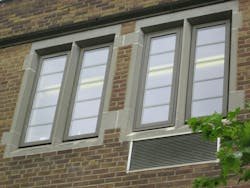Historic church gains energy efficiency, retains aesthetics with architecturally rated windows
After nearly half a century of use, Southminster Presbyterian Church’s steel window frames and single glass pane windows were in deplorable condition.
“About all they did was keep the rain and snow out but they let in all the heat and all the cold all of the time,” said the Rev. Dr. Daniel B. Merry, senior pastor, Southminster Presbyterian Church in Mt. Lebanon, a Pittsburgh suburb.
New windows would need to not only stand the test of time, but also accommodate the aesthetics of an architecturally historic church. The Norman Gothic style church was originally designed by renowned architect Thomas Pringle and built in 1928. An additional wing for educational programs and offices was added in the early 1950s. The educational wing includes the approximately 350 steel frame windows that needed to be replaced.
After receiving several bids from different companies, the Rev. Merry and Southminster Presbyterian Church chose GThurm windows from Graham Architectural Products.
“We thought GThurm windows were the best insulating window, and far superior to aluminum windows and their insulation value,” said the Rev. Merry. “We believe it is cutting-edge technology. We’d rather be on the front of the curve than the back of the curve.”
Graham Architectural Products’ GThurm high-efficiency windows are the first American-made, architecturally rated windows (AW) to feature thermal transmission measures as low as U 0.15 (R 7) using readily available insulating glass. The window lineals, which were created using the G2RP glass-reinforced polyurethane pultrusion process, offer improved dimensional stability, durability, thermal insulation and environmental friendliness over traditional windows. The polyurethane used to produce G2RP reinforced glass fibers is a unique polyurethane resin supplied by Bayer MaterialScience LLC that contains no volatile organic compounds (VOCs). Graham Architectural Products is a member of Bayer’s EcoCommercial Building (ECB) Network that strives to make net-zero energy buildings possible by bringing together leading companies that provide state-of-the-art product and service technologies.
“One of the primary benefits of the GThurm material technology is the lack of heat conduction,” said Jim Eisenbeis, director of marketing, Graham Architectural Products. “Aluminum is 700 times more heat conductive than our material, which is bad if you want to keep heat in or out of the building.”
Harry George, manager, new markets, Bayer MaterialScience LLC, said: “In this project, replacing the window frames alone provides significantly better thermal conductivity than the old steel frames. The GThurm product provides a more energy efficient window than a thermally broken aluminum window, or a steel frame window.”
Gibsonia, Pa.-based Windows Systems Inc. removed the old windows and installed the new models. The steel casement windows, originally installed with a fin that goes between the exterior stone and interior block wall, required an elaborate removal process, said Drake Core, vice president, Window Systems Inc.
One of the most important challenges was retaining the sight lines of the building even as the church requested a reduction of operable windows with fixed windows.
“This created a sight line issue,” Core said. “If one window opens and another one doesn’t, that affects the look from the outside due to the differing thickness. We downsized the fixed window and added to it so that it replicates an operable window and maintains a uniform appearance.”
Additionally, the presence of an on-site daycare facility required the installers to meet federal “renovate, repair, paint” regulations for lead paint. Core and his team went a step further and hired an outside consulting firm to monitor air quality and surfaces during and after the installation.
With those challenges solved, the installation of the new windows was cut and dried, he said. “It’s pretty much the same installation process as traditional aluminum windows,” Core said.
The newly installed windows offered an unexpected benefit for those who work in the church offices. The church is located at the corner of a busy main street and a cobblestone road. Two elementary schools and an emergency services department with a loud siren are also nearby. As such, the ambient neighborhood noise was often evident to people inside the church.
“After the project was completed, the first thing I noticed was the sound,” said the Rev. Merry. “The GThurm windows are so tight and well insulated that the quiet in the office and educational areas was immediately noticeable.
“And when the heat index soared to higher than 100 degrees for several days during a July 2011 heat wave, the offices with air conditioning units absolutely stayed cooler with the new windows than they had with the previous steel casement windows.”
Additionally, the windows provide not only improved insulation value but also superior strength. This is achieved through a pultrusion process in which 80 percent continuous stranded glass content is combined with 20 percent resin to produce window lineals, Eisenbeis explained.
Polyurethane chemistry offers many benefits over the chemistries traditionally used in the pultrusion process. Not only can polyurethane chemistries be customized on a project-by-project basis to provide greater strength, as well as better working and performance characteristics than polyesters, vinyl esters and epoxies; polyurethane resins are also free of the hazardous styrene emissions common to polyesters and vinyl esters.
Unlike traditional fiberglass window lineals, the GThurm window lineals pultruded with the G2RP require no additional reinforcement for structural integrity. The unique process allows for lightweight framing with superior structural performance and a thermal performance nearly triple that of ordinary architecturally-rated window products. The production of GThurm lineals is expected to use less energy per pound of raw materials than comparable aluminum designs, supporting a sustainable design.
“As government regulations ratchet up requirements for window insulation values, it will be increasingly difficult to install aluminum windows and meet requirements,” said Core. “The Southminster Presbyterian Church project demonstrates the viability of this new window technology.” +
